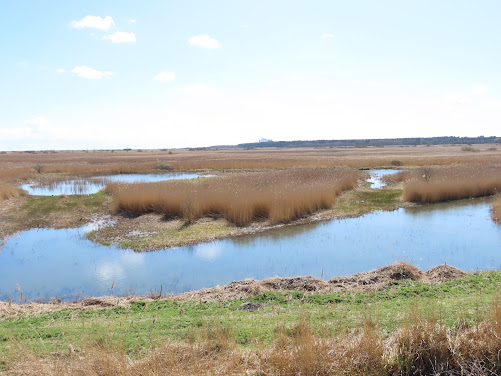With only a short time to spend at Minsmere today, I chose a leisurely stroll round Island Mere and its reedbeds, rather than a mad dash around the Scrape. And with a beautifully sunny day appearing out of the snows we previously had, it was a very nice experience. Being early April, this part of the reserve was brimming with the rising life of Spring, with so much bird action happening round here.
Island Mere is a large lake in the extensive reedbeds of Minsmere. Great views can be had from the top of Whin Hill above, but the birds are best seen from the hide which overlooks the Mere. Reedbeds are a habitat, like heathlands, where although bird numbers might be smaller, large growths of them support species of birds found in no other habitat. And Island Mere is probably the best place in the country to see those species, rare lurkers that they are.
Further down from Island Mere is the Bittern Hide, a viewbox built up in the trees that looks over the extensive reeds. Its well made and even in the strongest winds doesn't sway or even creak. Unlike Island Mere the small pool in front doesn't attract many birds, but you can see some of the reedbed specialists, usually flying about.
The variety of birds were good today on the Mere, although the number of birds were low. Star birds were the pair of long staying SMEW, which had been here since February, although they weren't very active, being asleep in the glare of the sun. The males are stunning, a monochrome black and white, with the females sporting a red head. What is strange about the smews is that they are birds of midwinter, bitterly cold days in January, yet the birds today have stayed on through a warm winter, into a warm spring, totally against their nature. This is my first April record for this species, the latest I have ever seen them stay on, and its got me wondering, what is nature making of this off kilter weather.
Two WHOOPER SWANS were also present, also midwinter birds staying on for some reason, its been a good winter for a bird at Minsmere that used to be rare here. Two pairs of GREAT CRESTED GREBE were around, and will probably nest here, as well as several COOT battling over territories, and small numbers of TUFTED DUCK, which you would expect at this time of year.
In the cut reeds in front of the hide two SNIPE were present, initially hiding in among the reeds, before coming out into the open and close to the hide, providing great views of a difficult to see bird. In the surrounding reedbeds MARSH HARRIERS were busy, with many birds on the wing, male and female, birds battling over territories, for nesting rights in among the reed fronds. One male bird corkscrewed down into the reeds, to its mate, an action known as sky dancing, something all harriers are famous for.
Excitement was added by a pair of BITTERNS on the wing near the hide, flying in the air for an extended time, before one flew across behind the Mere. Its always difficult to see this bird as it usually lurks at the bottom of the reeds and its only when they rarely fly that you see them. Another bird was also seen on the wing from Bittern Hide, but only briefly. It was good to see them today as the birds tend to hold tight when establishing territories at this time of year. Today a few birds were heard booming, that fog horn call of the bittern, the unique sound this brown heron of the reeds releases, which is the loudest sound emitted by any bird in the UK, a sound which carries right over the reserve.
So having enjoyed the reeds and the birds which lurk there, it was a stop off at the café for a well earned coffee to end the day. As luck would have it, by the Sand Martin bank just over the shoulder from the café, a BLACK REDSTART was lurking, first just a head appearing, before it flew up and perched on a fence showing itself off to the birders watching. Despite its name, its more of a charcoal grey bird, with a red tail which is noticeable in flight. Its a very rare breeding bird in the UK, usually in urban settings, with a couple of pairs down south at Sizewell power station, but its a common bird on the continent., seen in most villages A scarce migrant at this time of year it was a good bird to end the day on.









No comments:
Post a Comment